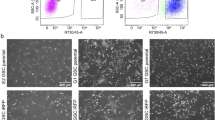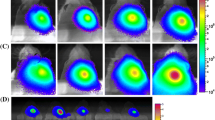Abstract
The development of imaging techniques in the experimental oncology has made it possible to model and continuously monitor growth and development of tumors in vivo. For this purpose, fluorescent or bioluminescent proteins are most commonly introduced into the genome of target cells which in turn can be used to create xenograft tumor models. In our study, SH-SY5Y human neuroblastoma cells were genetically modified with a firefly luciferase ffLuc gene or far-red fluorescent protein Katushka2S gene, and bioluminescence and fluorescence of obtained cells were analyzed in vitro. Then, produced cell lines were used to create xenograft tumor models in vivo. The bioluminescence and fluorescence of the obtained tumor models were evaluated in vivo. When evaluated in vitro, ffLuc bioluminescence was firstly detected within fewer number of SH-SY5Y cells compared to Katushka2S fluorescence. However, after in vivo administration, the fluorescence intensity of SH-SY5Y-Katushka2S cells was significantly higher than the bioluminescence intensity of the same number of SH-SY5Y-ffLuc cells. This may be due to the distribution and limited intracellular availability of a luciferase substrate, which is administered intraperitoneally, and requires further analysis.


Similar content being viewed by others
References
Cevenini, L., Camarda, G., Michelini, E., Siciliano, G., Calabretta, M. M., Bona, R., Kumar, T. R., Cara, A., Branchini, B. R., Fidock, D. A., Roda, A., & Alano, P. (2014). Multicolor bioluminescence boosts malaria research: Quantitative dual-color assay and single-cell imaging in Plasmodium falciparum parasites. Analytical Chemistry, 86(17), 8814–8821. https://doi.org/10.1021/ac502098w
Weissleder, R., & Nahrendorf, M. (2015). Advancing biomedical imaging. Proceedings of the National Academy of Sciences of the United States of America, 112(47), 14424–14428. https://doi.org/10.1073/pnas.1508524112
Chudakov, D. M., Matz, M. V., Lukyanov, S., & Lukyanov, K. A. (2010). Fluorescent proteins and their applications in imaging living cells and tissues. Physiological Reviews, 90(3), 1103–1163. https://doi.org/10.1152/physrev.00038.2009
Day, R. N., & Davidson, M. W. (2009). The fluorescent protein palette: Tools for cellular imaging. Chemical Society Reviews, 38(10), 2887–2921. https://doi.org/10.1039/b901966a
Ntziachristos, V. (2006). Fluorescence molecular imaging. Annual Review of Biomedical Engineering, 8, 1–33. https://doi.org/10.1146/annurev.bioeng.8.061505.095831
Kaskova, Z. M., Tsarkova, A. S., & Yampolsky, I. V. (2016). 1001 lights: Luciferins, luciferases, their mechanisms of action and applications in chemical analysis, biology and medicine. Chemical Society Reviews, 45(21), 6048–6077. https://doi.org/10.1039/c6cs00296j
Mezzanotte, L., van ’t Root, M., Karatas, H., Goun, E. A., & Lowik, C. (2017). In vivo molecular bioluminescence imaging: New tools and applications. Trends in Biotechnology, 35(7), 640–652. https://doi.org/10.1016/j.tibtech.2017.03.012
Halliwell, L. M., Jathoul, A. P., Bate, J. P., Worthy, H. L., Anderson, J. C., Jones, D. D., & Murray, J. A. H. (2018). DeltaFlucs: Brighter Photinus pyralis firefly luciferases identified by surveying consecutive single amino acid deletion mutations in a thermostable variant. Biotechnology and Bioengineering, 115(1), 50–59. https://doi.org/10.1002/bit.26451
Shigehisa, M., Amaba, N., Arai, S., Higashi, C., Kawanabe, R., Matsunaga, A., Laksmi, F. A., Tokunaga, M., & Ishibashi, M. (2017). Stabilization of luciferase from Renilla reniformis using random mutations. Protein Engineering, Design & Selection, 30(1), 7–13. https://doi.org/10.1093/protein/gzw056
Yu, T., Laird, J. R., Prescher, J. A., & Thorpe, C. (2018). Gaussia princeps luciferase: A bioluminescent substrate for oxidative protein folding. Protein Science, 27(8), 1509–1517. https://doi.org/10.1002/pro.3433
Kobayashi, H., Picard, L. P., Schonegge, A. M., & Bouvier, M. (2019). Bioluminescence resonance energy transfer-based imaging of protein-protein interactions in living cells. Nature Protocols, 14(4), 1084–1107. https://doi.org/10.1038/s41596-019-0129-7
Yeh, H. W., & Ai, H. W. (2019). Development and applications of bioluminescent and chemiluminescent reporters and biosensors. Annual Review of Analytical Chemistry, 12(1), 129–150. https://doi.org/10.1146/annurev-anchem-061318-115027
Iwano, S., Sugiyama, M., Hama, H., Watakabe, A., Hasegawa, N., Kuchimaru, T., Tanaka, K. Z., Takahashi, M., Ishida, Y., Hata, J., Shimozono, S., Namiki, K., Fukano, T., Kiyama, M., Okano, H., Kizaka-Kondoh, S., McHugh, T. J., Yamamori, T., Hioki, H., … Miyawaki, A. (2018). Single-cell bioluminescence imaging of deep tissue in freely moving animals. Science, 359(6378), 935–939. https://doi.org/10.1126/science.aaq1067
Hara-Miyauchi, C., Tsuji, O., Hanyu, A., Okada, S., Yasuda, A., Fukano, T., Akazawa, C., Nakamura, M., Imamura, T., Matsuzaki, Y., Okano, H. J., Miyawaki, A., & Okano, H. (2012). Bioluminescent system for dynamic imaging of cell and animal behavior. Biochemical and Biophysical Research Communications, 419(2), 188–193. https://doi.org/10.1016/j.bbrc.2012.01.141
Wood, K. V., Lam, Y. A., & McElroy, W. D. (1989). Introduction to beetle luciferases and their applications. Journal of Bioluminescence and Chemiluminescence, 4(1), 289–301. https://doi.org/10.1002/bio.1170040141
Yan, Y., Shi, P., Song, W., & Bi, S. (2019). Chemiluminescence and bioluminescence imaging for biosensing and therapy: In vitro and in vivo perspectives. Theranostics, 9(14), 4047–4065. https://doi.org/10.7150/thno.33228
Chulpanova, D. S., Solovyeva, V. V., James, V., Arkhipova, S. S., Gomzikova, M. O., Garanina, E. E., Akhmetzyanova, E. R., Tazetdinova, L. G., Khaiboullina, S. F., & Rizvanov, A. A. (2020). Human mesenchymal stem cells overexpressing interleukin 2 can suppress proliferation of neuroblastoma cells in co-culture and activate mononuclear cells in vitro. Bioengineering, 7(2), 59. https://doi.org/10.3390/bioengineering7020059
Kolobynina, K., Solovyeva, V., Gomzikova, M., Tazetdinova, L., & Rizvanov, A. (2017). Generation of human adipose-derived stem cell lines with expression of TESC gene. BioNanoScience, 7(1), 92–96. https://doi.org/10.1007/s12668-016-0299-5
Solovyeva, V. V., Kolobynina, K. G., Gomzikova, M. O., Tazetdinova, L. G., Zhuravleva, M. N., Slepak, V. Z., & Rizvanov, A. A. (2015). Effect of tescalcin overexpression on osteogenic differentiation of human mesenchymal stem cells. Genes and Cells, 10(4), 90–93.
Souris, J. S., Hickson, J. A., Msezane, L., Rinker-Schaeffer, C. W., & Chen, C. T. (2013). Flexible peritoneal windows for quantitative fluorescence and bioluminescence preclinical imaging. Molecular Imaging, 12(1), 28–38.
Yip, D., Kirkpatrick, A., Xu, T., Masi, T., Stephenson, S., Ripp, S., & Close, D. (2020). Continuous and real-time in vivo autobioluminescent imaging in a mouse model. Methods in Molecular Biology, 2081, 191–201. https://doi.org/10.1007/978-1-4939-9940-8_13
Wang, K., Xie, S., Ren, Y., Xia, H., Zhang, X., & He, J. (2012). Establishment of a bioluminescent MDA-MB-231 cell line for human triple-negative breast cancer research. Oncology Reports, 27(6), 1981–1989. https://doi.org/10.3892/or.2012.1742
Bindhu, J., Das, A., & Sakthivel, K. M. (2020). Anthraquinone from edible fungi Pleurotus ostreatus protects human SH-SY5Y neuroblastoma cells against 6-hydroxydopamine-induced cell death-preclinical validation of gene knockout possibilities of PARK7, PINK1, and SNCA1 using CRISPR SpCas9. Applied Biochemistry and Biotechnology, 191(2), 555–566. https://doi.org/10.1007/s12010-019-03188-7
Menke, K., Schwermer, M., Schramm, A., & Zuzak, T. J. (2019). Preclinical evaluation of antitumoral and cytotoxic properties of Viscum album fraxini extract on pediatric tumor cells. Planta medica, 85(14–15), 1150–1159. https://doi.org/10.1055/a-1013-0382
Meleshina, A., Cherkasova, E., Sergeeva, E., Turchin, I., Kiseleva, E., Dashinimaev, E., Shirmanova, M., & Zagainova, E. (2013). Fluorescent bioimaging in the study of the different models “stem cells-tumor” interaction. The FEBS Journal, 280, 446.
Xu, T., Close, D. M., Webb, J. D., Ripp, S. A., & Sayler, G. S. (2013). Autonomously bioluminescent mammalian cells for continuous and real-time monitoring of cytotoxicity. Journal of Visualized Experiments, 80, e50972. https://doi.org/10.3791/50972
Xu, T., Conway, M., Frank, A., Ripp, S., Sayler, G., & Close, D. (2017). Co-cultured continuously bioluminescent human cells as bioreporters for the detection of prodrug therapeutic impact pre- and post-metabolism. Sensors, 17(12), 2827. https://doi.org/10.3390/s17122827
Alsawaftah, N., Farooq, A., Dhou, S., & Majdalawieh, A. F. (2021). Bioluminescence imaging applications in cancer: A comprehensive review. IEEE Reviews in Biomedical Engineering, 14, 307–326. https://doi.org/10.1109/RBME.2020.2995124
Lim, W., Kim, B., Jo, G., Yang, D. H., Park, M. H., & Hyun, H. (2020). Bioluminescence and near-infrared fluorescence imaging for detection of metastatic bone tumors. Lasers in Medical Science, 35(1), 115–120. https://doi.org/10.1007/s10103-019-02801-9
Acknowledgements
The work was performed according to the Russian Government Program of Competitive Growth of Kazan Federal University.
Funding
This paper was funded by the subsidy allocated to KFU for the state assignment 0671–2020-0058 in the sphere of scientific activities and by the Kazan Federal University Strategic Academic Leadership Program (PRIORITY-2030) and by the Grant of Russian Foundation for Basic Research №18–34-00738.
Author information
Authors and Affiliations
Contributions
Study was designed by Daria S. Chulpanova, Leysan G. Tazetdinova, Valeriya V. Solovyeva, and Albert A. Rizvanov. Svetlana S. Arkhipova, Mikhail O. Mavlikeev, and Aysilu I. Mullagulova made in vivo injections and BLI, FLI. Data analyses and interpretation were performed by Daria S. Chulpanova, Leysan G. Tazetdinova, and Valeriya V. Solovyeva. Manuscript was written by Daria S. Chulpanova, Leysan G. Tazetdinova, and Valeriya V. Solovyeva. All authors revised the manuscript and approved the final version.
Corresponding author
Ethics declarations
Research Involving Humans and Animals Statement
All experiments were carried out in compliance with the procedure protocols approved by Kazan Federal University local ethics committee (protocol No. 3, date 03/23/2017) according to the rules adopted by Kazan Federal University and Russian Federation Laws.
Informed Consent
Not applicable.
Conflict of Interest
The authors declare no competing interests.
Additional information
Publisher's Note
Springer Nature remains neutral with regard to jurisdictional claims in published maps and institutional affiliations.
Rights and permissions
About this article
Cite this article
Chulpanova, D.S., Tazetdinova, L.G., Arkhipova, S.S. et al. In Vivo Visualization of Stable Neuroblastoma Cell Lines with Overexpression of Firefly Luciferase or Far-Red Fluorescent Protein. BioNanoSci. 12, 662–669 (2022). https://doi.org/10.1007/s12668-022-00967-1
Accepted:
Published:
Issue Date:
DOI: https://doi.org/10.1007/s12668-022-00967-1




